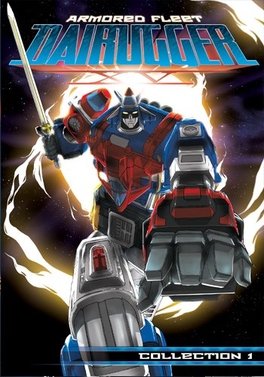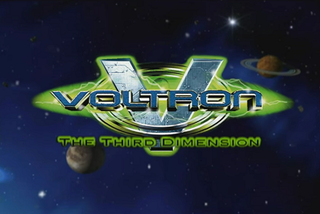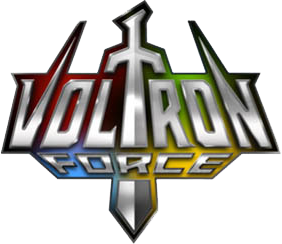
Voltron is an American animated television series franchise that features a team of space explorers who pilot a giant super robot known as "Voltron". Produced by Peter Keefe and Ted Koplar through his production company World Events Productions, Voltron was an adaptation of several Japanese anime television series from Toei Animation. The original television series aired in syndication from September 10, 1984, to November 18, 1985. The first season of Voltron, featuring the "Lion Force Voltron", was adapted from the series Beast King GoLion. The second season, featuring the "Vehicle Team Voltron", was adapted from the unrelated series Armored Fleet Dairugger XV.

Armored Fleet Dairugger XV is a mecha anime series aired in Japan from 1982 to 1983 for 56 episodes.

WEP LLC, doing business as World Events Productions, is an American-based animation and distribution company in St. Louis, Missouri, best known for releasing the anime titles Voltron, Defender of the Universe and Saber Rider and the Star Sheriffs, as well as producing the original animated series Denver, the Last Dinosaur.

Lightspeed Electroid Albegas is an anime series that aired from 1983 to 1984 in Japan, Latin America, Spain and Italy. There were 45 episodes aired at 25 minutes each. Other loosely translated names are "Arbegas", "Arebegas", "Lightspeed ElectroGod Arbegas" and "Arbegas: El Rayo Custodio".

Voltron: The Third Dimension is an American animated television series produced by World Events Productions. It is a sequel to the 1980s animated series Voltron: Defender of the Universe and is set five years after the end of the series. Neil Ross, Michael Bell, and B.J. Ward reprised their roles as Keith, Lance, and Princess Allura for the series. The show was animated by Netter Digital Entertainment, inc. and Mike Young Productions. It departed from the original Voltron's animated look, as well as some character changes, such as the physical appearance of Prince Lotor.

Voltron: Fleet of Doom is an American-Japanese television special involving heroes of both Voltron series working together to defeat their sworn enemy, King Zarkon, who aligns with the remnants of Emperor Zeppo's Drule Empire to create a mighty armada called the Fleet of Doom.

Voltron Force is an American animated television series that premiered on June 16, 2011, exclusively on the Nicktoons television network. It is a sequel to the 1980s animated series Voltron and the 1999 CGI series Voltron: The Third Dimension. It ended after one season on April 25, 2012, with the planned second season being unproduced.

Voltron: Defender of the Universe is a twin stick shooter adventure game based on the Voltron television series, developed by Behaviour Interactive and published by THQ. The game was released on November 29, 2011 for PlayStation 3 and released on November 30, 2011 for Xbox 360. The game allows players to play as all five lions from the series and to control Voltron, a huge robot formed by combining those lions. The game received mixed reception among critics. Some reviewers were critical of the Voltron robot gameplay sequences, yet others praised the lion sequences. Most critics spoke highly of the fan service given. The game is now delisted and not available for purchase. However the game is still available on the UK psn store.
Voltron is the name of two past comic book series and one current series published by different companies. Both previous series are based on the television series Voltron. Voltron is the name of the robot that the main characters pilot to fight evil in space. The series stars five young soldiers who are recruited to find the title character in deep space, and to use Voltron to defend the galaxy.

Voltron: Legendary Defender is an American animated mecha television series produced by DreamWorks Animation Television and World Events Productions. It is animated by South Korean studio Mir for Netflix. It is a reboot of the Voltron franchise and the Japanese anime series Beast King GoLion. Its animation is a mix of anime-influenced traditional animation for characters and backgrounds and CGI for Voltron action sequences. Voltron: Legendary Defender is set in a science fiction universe where planetary energy called quintessence can be used to power vehicles and magic. The series follows the adventures of the Paladins of Voltron who must learn to work together to form the legendary robot Voltron and use it to defeat the Emperor Zarkon and the Galra Empire. The series ran from June 10, 2016 to December 14, 2018, having released 78 episodes over 8 seasons.
"The Rise of Voltron" is the first three episodes of Voltron: Legendary Defender. It was directed by Joaquim Dos Santos and Lauren Montgomery and written by Tim Hedrick, Joshua Hamilton and May Chan. In this episode, three cadets at the Galaxy Garrison: Lance, Pidge, and Hunk along with Garrison dropout Keith, and Takashi 'Shiro' Shirogane, the leader of the Defenders of the Universe, who was captured by the villainous Galra Empire a year before the events of the series, are tasked by Princess Allura of Altea with finding five robotic lions to form Voltron.
Keith Akira Kogane, known as Chief Akira Kogane in the original Japanese language Beast King GoLion, is a fictional character in the media franchise Voltron and leader of the Voltron Force, who made his debut appearance in Defender of the Universe.
Lance Charles McClain, known as Isamu "Moody" Kurogane in the original Japanese language Beast King GoLion, is a fictional character in the media franchise Voltron and a member of the Voltron Force, who made his first appearance in Voltron: Defender of the Universe.
Princess Allura, known as Princess Farla in the original Japanese language Beast King GoLion, is a fictional character in the media franchise Voltron and member of the Voltron Force, who made her first appearance in Voltron.
Emperor Zarkon, known as Emperor Daibazaal in the original Japanese language Beast King GoLion, is a fictional character in the media franchise Voltron and an antagonist of the Voltron Force, who made his first appearance in Voltron.
Darrell "Pidge" Stoker, known as Hiroshi "Shorty" Suzuishi in the original Japanese language Beast King GoLion, is a fictional character in the media franchise Voltron, and a member of the Voltron Force. The character's first appearance was in Voltron.
Prince Lotor, known as Prince Imperial Sincline in the original Japanese language Beast King GoLion and in the sixth season of Voltron: Legendary Defender, is a fictional character in the media franchise Voltron, and is an antagonist of the Voltron Force who made his first appearance in Voltron.
Sven Holgersson, known as Takashi "Shiro" Shirogane is a fictional character in the media franchise Voltron, and a member of the Voltron Force. The character's first appearance was in Voltron: Defender of the Universe. The character has received a positive critical reception, although their depiction as a gay man in Legendary Defender has been criticised as being poorly written.
Tsuyoshi "Hunk" Garret, known as Tsuyoshi Seidou or by his nickname Hothead in the original Japanese language Beast King GoLion, is a fictional character in the media franchise Voltron, and a member of the Voltron Force. The character's first appearance was in Voltron.









